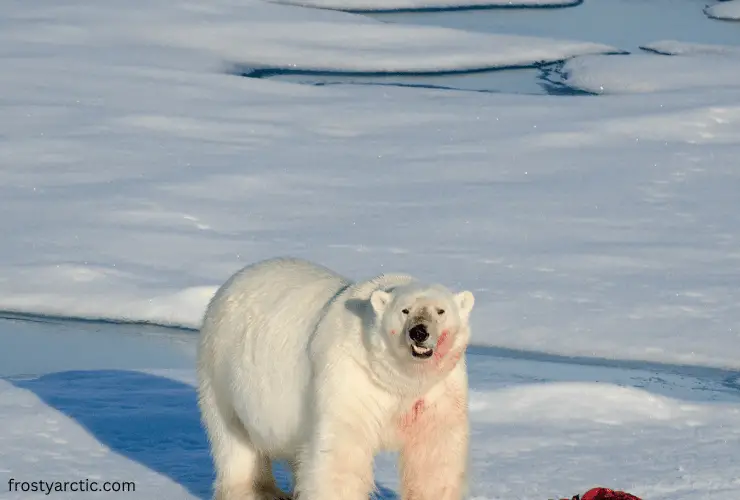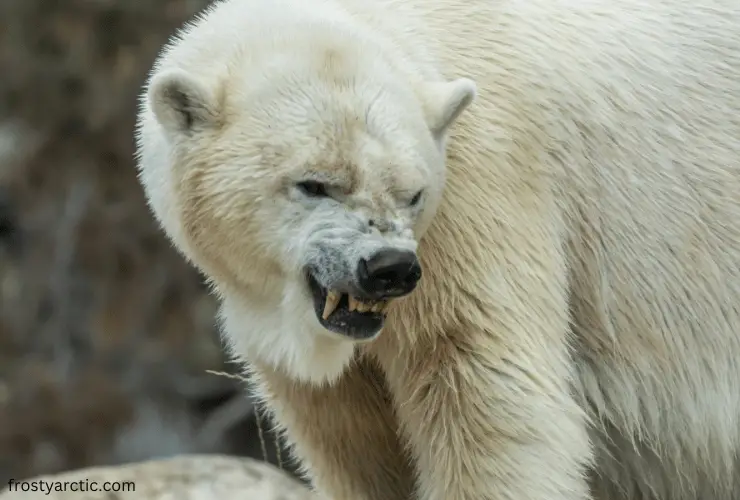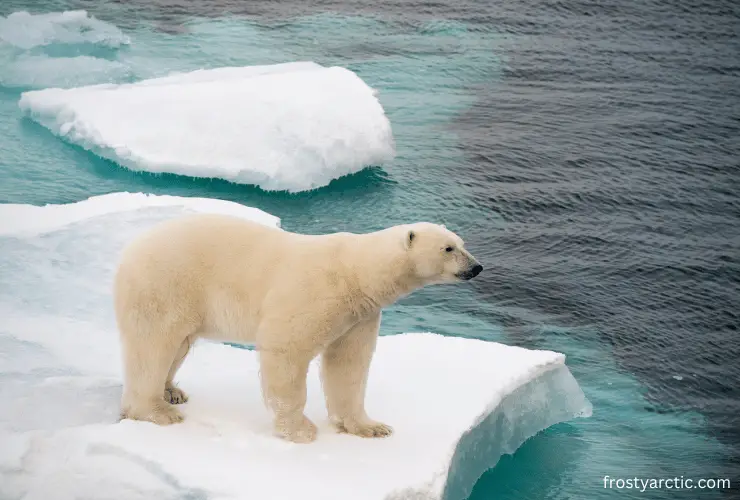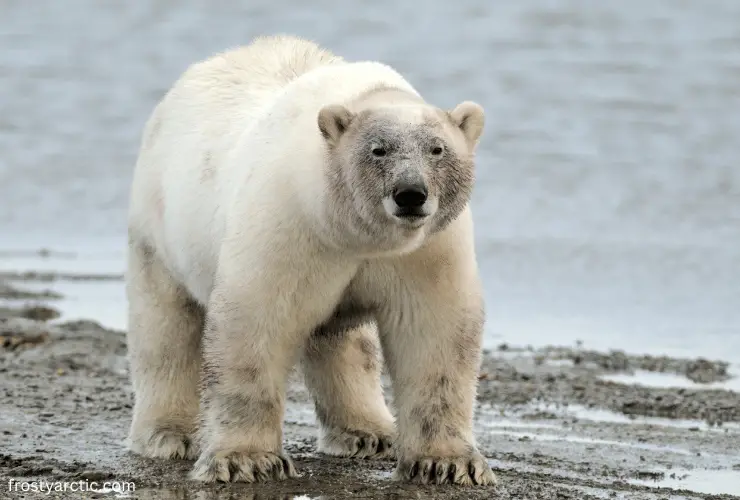The answer to this is no. Polar bears do not hunt humans. If a polar bear is well-fed and happy, it will never come looking for humans to hunt and may even try their best to avoid confronting a human. The bottom line is, polar bears do not hunt humans.
From 1870 to 2014, there have been only a handful of attacks on humans by polar bears. This means the probability of a bear hunting a human is very rare. However, this doesn’t mean there is no chance that a polar bear will attack you. If a polar bear is malnourished and young, it may attack a human.
Do Polar Bears Hunt or Eat Humans?
Polar bears rarely hunt humans. A survey enrolled by Todd C. Atwood (United States Geological Survey specialist), James Wilder Dag, and Vongraven about polar bear attacks on humans. They published their survey report on a Geological research site. In the survey conducted from 1870 to 2014, they were able to record only 73 attacks.
Out of these 73 attacks, only 20 were fatal. It was later observed that these incidents were caused by hungry male polar bears or protective female bears guarding their cubs (source).
Although polar bears are aimless predators and may consider lone humans as potential prey when hungry, actual attacks on humans are extremely infrequent.
If you want to minimize the risk of such potentially dangerous encounters, researchers emphasized the importance of showing respect and being very cautious when entering a polar bear’s habitat.
Do Polar Bear Cubs Also Eat Humans?
It is very rare; however, polar bears can become dangerous and attack humans when they are extremely hungry and desperate for food. As the polar ice continues to melt, food availability has greatly decreased, and their habitats have been reduced. As a result, the likelihood of these encounters is anticipated to rise.
Do Polar Bears Hunt and Kill Humans for Fun?

If you’re wondering whether polar bears would hunt and kill you just for fun if you came in front of them, well, here is the answer. Polar bears do not hunt and kill humans for fun.
As carnivorous predators, they prey primarily on seals. As we mentioned earlier, Human attacks by polar bears are exceedingly rare and usually occur due to extreme hunger or to defend themselves.
In their natural environment, polar bears would normally prioritize hunting seals to eat and generally avoid any confrontations with humans.
Some Incidents Occurring in Different States: Polar Bears Attacked Humans
To gather information on polar bear interactions with humans, a database named the Polar Bear-Human Information Management System (PBHIMS) was created. With the help of this analysis, the number of incidents of polar bears attacking humans has been revealed.
These attacks took place across the five main polar bears Range States including Norway, Russia, Canada, Greenland, and the United States.
These attacks injured people (we already mentioned above the stats). It was later observed that these attacks took place due to the adult male polar bears being stressed nutritionally.
On the other hand, attacks by female polar bears were infrequent and mostly due to them getting defensive for their cubs. The majority of these attacks were categorized as predatory behavior by the bears, and in nearly all cases, the attacks involved no more than two individuals.
Now, it is crucial to heighten concerns for both human and bear safety as there is a higher chance of these wild animals coming on land due to the loss of their habitats and food.
Are Polar Bear Attacks on Humans Increasing Because of Climate Change?
Climate change has impacted a lot of animals and their natural habitats. Just like that, polar bears have been affected by global warming in very negative ways.
Rising temperatures are the main cause of melting the sea ice that polar bears navigate to find mates, raise cubs and hunt seals to maintain their high-fat diet. The shrinking ice has reduced the availability of their food and put the population of polar bears at risk of decline as well.
Scientists have now discovered that climate change is forcing polar bears to spend more time inland than they have ever done in the past. This is increasing the possibility of run-ins that could be dangerous both for humans and bears.
This means that if climate change makes polar bears extremely desperate, it might lead to an increase in humans being attacked.
Will Polar Bears Actively Hunt Humans?

Normally, polar bears avoid confronting humans and do not attack and hunt them unless they feel troubled or are extremely hungry. It can be predicted that polar bears will actively hunt humans due to global warming and its effects on them.
However, there is no scientific evidence that polar bears will actively hunt humans and use humans as their only food source in the future. But polar bears, especially young and undernourished ones, have been known to hunt humans for food. So, no one can be certain and say that polar bears will actively hunt humans soon, although it is inevitable.
Are Polar Bears Man-Eaters?
If you’re wondering what exactly a man-eater is, we’ve got you covered. A man-eater is an animal whose hunting behavior involves preying on humans. If we go into further detail, man-eating animals do not include those animals that attack a human once out of extreme starvation, eating a corpse, or killing as an act of self-defense.
When it comes to polar bears, the young and undernourished ones might begin hunting humans for food occasionally. As mentioned, many times before, such incidents are rare as bears usually do not target humans. Despite this, when polar bears do attack, they cause severe injuries because of their enormous size and how strong they are.
From this, we learn that such incidents where bears become real man-eaters are uncommon, but this doesn’t mean that they are not inevitable. Polar bears may become man-eaters if they are tempted and sense danger from any human.
Do Polar Bears Fear Humans?
Looking at the statistics, there has been very little interaction between polar bears and humans throughout history. Only 73 people have been harmed by polar bears before. With this understanding, we learn that there is no proper evidence that tells us whether polar bears fear humans.
However, it is quite obvious that being the massive creatures that polar bears are, they most probably do not fear humans. This also means that they are pretty dangerous. If you ever go to an area where you might confront a polar bear, you must make sure to take the appropriate tools and equipment to scare them away if they are in danger.
Can a Polar Bear be Friendly with Humans?
If after learning everything we have so far you still believe that there’s a chance that polar bears could be friendly with humans, then let’s jump right into it.
Polar bears are absolutely huge animals that have the sharpest teeth and claws one could ever imagine! With this being said, it is obvious that polar bears can not be friendly with humans at all. This is because a polar bear will never think twice before attacking a human if they ever feel threatened, protective of their cubs, or if they are extremely hungry.
The worst part is, these not-so-friendly animals are now moving into areas where humans live due to the frequent loss of their habitats.
Do Polar Bears Hunt Humans in their Territories or Outside their Regions?

Polar bears normally do not attack humans and humans normally don’t go to places where polar bears live because it is quite cold there. However, due to global warming and climate change, polar ice caps are melting drastically. This is causing polar bears to move inland and into areas where humans live.
Now, since polar bears are entering areas where humans are, they may hunt humans in their own territories as well as in other regions where humans live.
What to Do if We Encounter a Polar Bear? How to Stay Safe in Polar Bear Country?
Knowing that polar bears are such dangerous wild animals and can hunt humans down easily, you need to know how to stay safe in a country where polar bears can come out.
Here are some precautions you must follow if you encounter a polar bear to stay safe:
- If you spot a polar bear in the distance, try to remain calm and avoid sudden movements or loud noises that could startle the bear.
- Evaluate the bear’s behavior and distance. If the bear is far away and not approaching you, you may have time to slowly and quietly move away without disturbing it.
- Under no circumstances should you approach a polar bear. Maintain a respectful distance and do not attempt to get closer for photos or any other reason.
- If you’re traveling with others, stay together as a group. Larger groups can appear more intimidating to bears, potentially deterring their approach.
- Carry deterrents such as bear spray, noise-making devices, and flares. These can be effective tools to discourage a curious or approaching bear.
- Direct eye contact might be perceived as a threat. Keep your gaze downward and avoid staring at the bear.
- If the bear begins to approach, slowly and carefully start to back away while keeping your eyes on the bear. Avoid turning your back on the bear, as sudden movements could trigger its predatory instincts.
- Speak to the bear calmly. This might help the bear identify you as a human and not as prey.
- If the bear continues to approach and shows interest in you, be ready to use your deterrents. Bear spray, noise, and flares can help deter the bear from getting closer.
- If you are near a secure location, such as a vehicle or building, move towards it cautiously. Such structures can protect the bear.
- If a polar bear attacks you, your best course of action is often to play dead. Lie flat on your stomach with your hands clasped behind your neck to protect your head. Spread your legs to make it more difficult for the bear to turn you over. Polar bears may lose interest if they don’t perceive you as a threat.
Remember, prevention is key. Educate yourself about polar bear behavior and safety protocols before visiting these regions.
FAQs’
Can we Touch a Polar Bear?
No, it is not safe to touch a polar bear in the wild or any other natural setting. Polar bears are wild animals and can be very dangerous. They are powerful predators with sharp claws and teeth, and their behavior is always pretty unpredictable.
Can a Polar Bear Attack Children?
Yes, a polar bear can potentially attack children, just as it can attack adults or any other living beings. When polar bears feel threatened, hungry, or provoked, they may start to exhibit aggressive behavior toward any perceived threat which might also include children.
Who will Win in a Fight, a Polar Bear or a Human?
The answer to this is pretty obvious. It is crucial to avoid confronting polar bears in the first place and then take precautions. So, if you were to get in a fight with a polar bear, it would use its claws and sharp teeth to attack you and the polar bear would win. Hence, it is best to keep your distance from these wild animals and not get in a fight with one.
What Would Happen If I Threw a Rock at a Wild Polar Bear?
According to precautions you should take when confronting any wild animal, it is best to keep your distance. If you throw a rock at a wild polar bear, it will probably react aggressively. Provoking a wild polar bear by doing so can end up in it attacking you as a defense mechanism.
What Would Happen If I Picked up a Wild Polar Bear Cub and gave it Hugs and Kisses?
You might think polar bear cubs are adorable and want to pick it up and give it hugs and kisses, but keep in mind that they are still wild predators, and their instincts and behaviors can be unpredictable. Attempting to interact with a wild polar bear cub could trigger defensive behavior from the mother bear, who will fiercely protect her young by showing aggressive behavior.
Do Polar Bears eat their Young?
Ian Stirling, a biologist from the University of Alberta and Environment Canada, highlights this phenomenon as a survival strategy for polar bears during times of food scarcity. According to scientific research, polar bears may eat cubs during late summer and autumn, when their primary prey, seals, are less available as they spend more time at sea. During this period, one of the few food sources left for polar bears is, in fact, cubs of various ages.
Conclusion
In a nutshell, it is essential to understand the dynamics between polar bears and humans to maintain safety in polar bear countries. While the idea of polar bears actively hunting humans is not supported by scientific evidence, it is clear that certain circumstances can lead to such interactions where polar bear attacks are quite inevitable.
However, climate change and habitat loss force polar bears to find food sources on land, and the potential for encounters with humans increases. Being prepared, and well-informed about polar bear behavior is also very important when entering into polar bear habitats.
You must follow safety protocols, such as maintaining a safe distance, carrying deterrents, and understanding how to respond during an encounter, to reduce the risk of dangerous interactions.



5 thoughts on “Do Polar Bears Hunt Humans? [Know When & Why]”